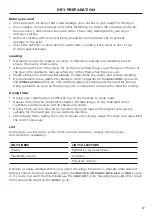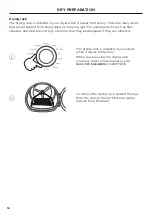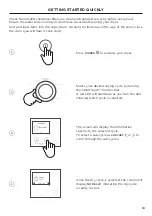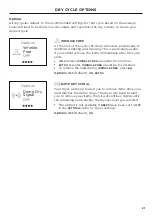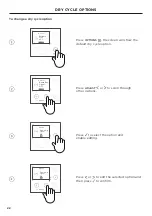
7
SAFETY AND WARNINGS
z
Do not dry curtains in your dryer. Sunlight makes them brittle and they may
disintegrate during drying.
z
Do not use the water collected in the water tank for drinking or food processing.
z
Never run the dryer without the water tank in place.
z
If the water tank becomes full, the tumble dryer will pause drying and will sound an
alarm. You must empty the water tank before the dryer can continue drying. Empty the
tank, replace it back in the housing then press
to resume the cycle.
Lint
z
Accumulated lint in the dryer can become a fire hazard; it also reduces the efficiency of
the dryer by causing longer drying times and increased power consumption.
z
Clean the lint filter before every load.
z
Ensure the area around the dryer is clear of lint.
z
At regular intervals have the interior of the dryer cleaned of any accumulated lint.
This must be done by a Fisher & Paykel trained and supported service technician.
This must be done when the dryer installation is changed from free standing.
z
If the lint filter becomes damaged, contact your Fisher & Paykel trained and supported
service technician to arrange getting a new filter. Do not operate your dryer with a
damaged lint filter or without the filter in place, as this will cause damage to your dryer.
Spontaneous combustion
To reduce the risk of fire in a tumble dryer the following should be observed:
z
Items that have been spotted or soaked with vegetable oil or cooking oil are a fire
hazard and should not be placed in a tumble dryer.
z
Oil-affected items can ignite spontaneously, especially when exposed to heat sources
such as a tumble dryer. The items become warm causing an oxidation reaction in the
oil. This oxidation creates heat. If the heat cannot escape the items can become hot
enough to catch fire. Piling, stacking or storing oil-affected items can prevent heat from
escaping creating a fire hazard.
z
If it is unavoidable that fabrics that contain vegetable oil, cooking oil or have been
contaminated by hair care products be placed in a tumble dryer, they should first be
washed in hot water with extra detergent — this will reduce, but not eliminate the fire
hazard. The cool down cycle of the dryer should be used to reduce the temperature
of these items. They should not be removed from the tumble dryer and piled or
stacked while hot.
z
Items that have previously been cleaned in, washed in, soaked in or spotted with
flammable liquids or solids, eg petrol/gasoline, kerosene, dry cleaning solvents,
vegetable or cooking oil, acetone, denatured alcohol, some brands of spot removers,
turpentine, waxes and wax removers or other flammable or explosive substances should
not be placed in a tumble dryer.
z
Do not dry unwashed items in the tumble dryer.
z
The dryer is not to be used if industrial chemicals have been used for cleaning.
z
Fabric Softeners or similar products should not be used in a tumble dryer to
eliminate the effects of static electricity, unless this practice is specifically
recommended by the manufacturer of the fabric softener product.
z
Rubber backed articles, foam rubber (latex foam), clothes or pillows fitted with
foam rubber pads, fibreglass, shoes containing rubber, shower caps, babies waterproof
napkin covers and waterproof textiles should not be dried in the dryer. These materials
can when heated produce fire by spontaneous combustion.
z
When using
STREAM REFRESH
on unwashed clothing ensure there are no flammable
substances on them.

















